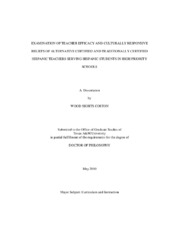| dc.contributor.advisor | Larke, Patricia J. | |
| dc.creator | Coston, Wood Sights | |
| dc.date.accessioned | 2011-08-08T22:47:36Z | |
| dc.date.accessioned | 2011-08-09T01:32:43Z | |
| dc.date.available | 2011-08-08T22:47:36Z | |
| dc.date.available | 2011-08-09T01:32:43Z | |
| dc.date.created | 2010-05 | |
| dc.date.issued | 2011-08-08 | |
| dc.date.submitted | May 2010 | |
| dc.identifier.uri | https://hdl.handle.net/1969.1/ETD-TAMU-2010-05-7708 | |
| dc.description.abstract | The purpose of this mixed method study was to examine teacher self efficacy and culturally responsive self efficacy of in-service Hispanic teachers teaching in high priority schools which serve large percentages of students of color with respect to the teachers' route to certification (alternative or traditional). This study also personal narratives to explore highly effective both alternatively and traditionally certified inservice teachers. The three guiding research questions for this mixed method study were: 1. What are teacher efficacy beliefs of alternatively certified teachers and traditionally certified Hispanic teachers who work in high priority schools serving Hispanic students? 2. What are culturally responsive beliefs of alternative certified teachers and traditionally certified Hispanic teachers who work in high priority schools serving Hispanic students? 3. What are the voices of highly effective alternative certified teachers and traditionally certified Hispanic teachers who work in high priority schools serving Hispanic students?Participants in the quantitative portion of the study were 90 middle and high school in-service teachers teaching in high priority schools in the Texas/Mexico borderlands of South Texas. The participants (N=4) in the qualitative portion of the study were purposively drawn from the quantitative participants. Findings of the study were derived from the use of two questionnaires (Teacher Self Efficacy Scale & Culturally Responsive Teacher Self Efficacy Scale) and an in-depth semi-structured interview with four participant in-service teachers. The major findings in this study were: 1. There are no significant differences in teacher self efficacy between alternatively certified teachers and traditionally certified teachers. 2. There are no significant differences in culturally responsive teacher self efficacy between alternatively certified teachers and traditionally certified teachers. 3. Sample population of Hispanic teachers scored themselves as having high teacher self efficacy and culturally responsive self efficacy. 4. The themes from teachers participating in the narrative portion of the study were: (a) high levels of teacher expectations, (b) effective school/parent relationships, (c) effective use of previous work experience, (d) utilization of the funds of knowledge of the students, (e) effective teacher/student connection, and (f) consistent use of self reflection. | en |
| dc.format.mimetype | application/pdf | |
| dc.language.iso | en_US | |
| dc.subject | culturally responsive efficacy | en |
| dc.subject | teacher efficacy | en |
| dc.subject | hispanic teachers | en |
| dc.subject | high priority schools | en |
| dc.subject | alternative certification | en |
| dc.subject | traditional certification | en |
| dc.title | Examination of Teacher Efficacy and Culturally Responsive Beliefs of Alternative Certified and Traditionally Certified Hispanic Teachers Serving Hispanic Students in High Priority Schools | en |
| dc.type | Thesis | en |
| thesis.degree.department | Teaching, Learning, and Culture | en |
| thesis.degree.discipline | Curriculum and Instruction | en |
| thesis.degree.grantor | Texas A&M University | en |
| thesis.degree.name | Doctor of Philosophy | en |
| thesis.degree.level | Doctoral | en |
| dc.contributor.committeeMember | Lewis, Chance W. | |
| dc.contributor.committeeMember | Webb-Johnson, Gwendolyn C. | |
| dc.contributor.committeeMember | Lira, Juan R. | |
| dc.type.genre | thesis | en |
| dc.type.material | text | en |


